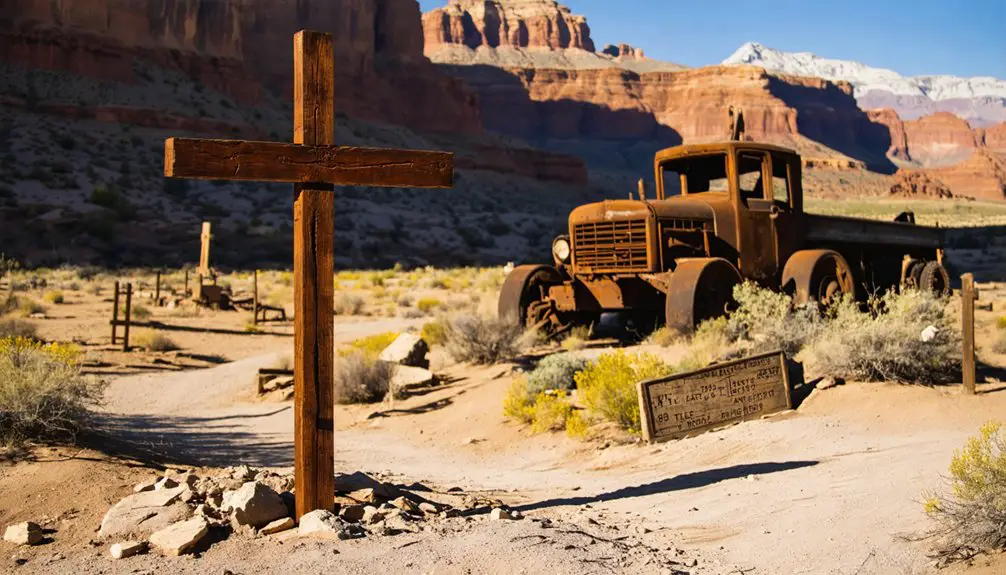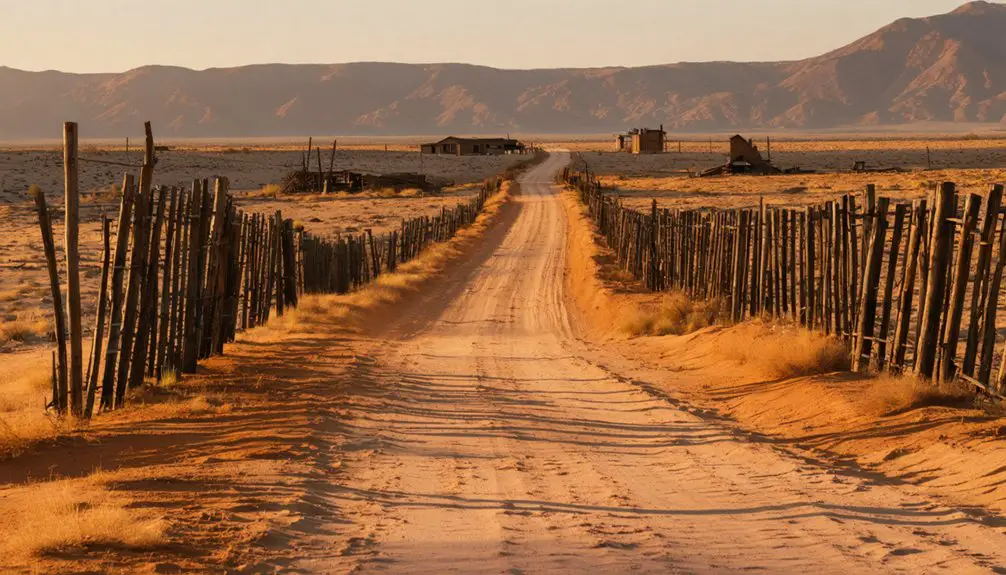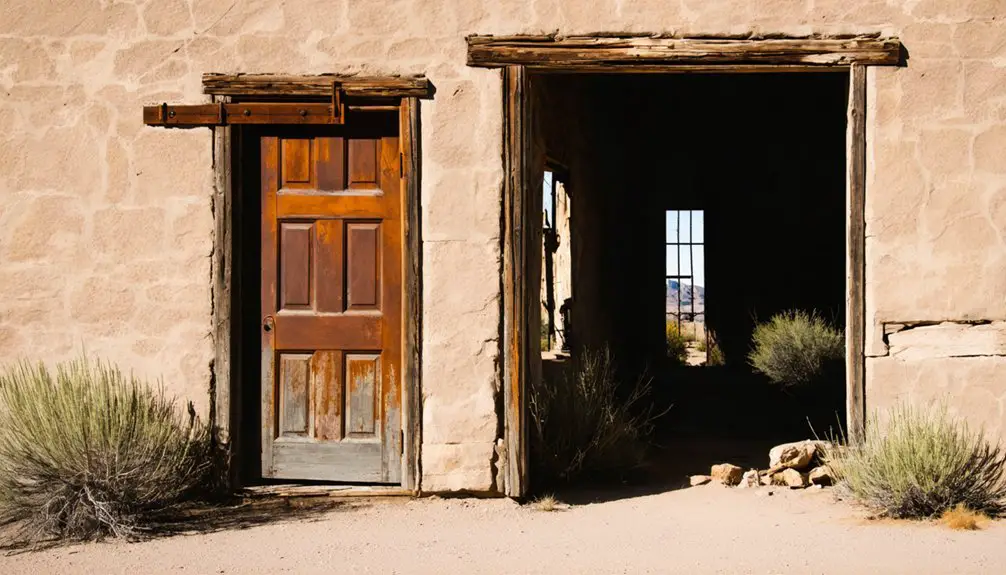You’ll find Diamond’s haunting remains in Utah’s Tintic Mining District, where an 1870s silver rush sparked a vibrant frontier community. Though prospectors initially mistook quartz for diamonds, the town flourished with five saloons, four stores, and three hotels, peaking at 900 residents. By 1923, flooding in the mines and dwindling profits led to Diamond’s abandonment. Today, the historic cemetery and scattered mine tailings whisper stories of fortune-seekers and their vanished dreams.
Key Takeaways
- Diamond was a mining town founded in 1870 in Utah’s Tintic Mining District after crystals were mistakenly identified as diamonds.
- At its peak in 1875, Diamond had 900 residents, five saloons, four stores, three hotels, a post office, and a school.
- Mining operations reached depths of 300 feet before severe flooding made deeper excavation unprofitable, leading to the town’s decline.
- By 1923, all buildings had been relocated, transforming Diamond into a ghost town with only mine tailings remaining.
- The Diamond Cemetery, listed on the National Historic Register since 1979, is the most significant remaining feature of the former town.
The Birth of a Diamond Dream
In the heart of Utah’s mineral-rich Tintic Mining District, Diamond’s story began in 1870 when a Jewish lapidary’s discovery of brilliant crystals sparked a rush of prospectors to the area.
While the initial diamond discovery turned out to be quartz, you’ll find that this misconception didn’t dampen the town’s pioneering spirit.
The settlement quickly grew as miners and entrepreneurs flocked to the promising location, demonstrating remarkable community resilience in establishing essential services. Located just five miles south of Eureka, Diamond became a hub of mining activity in the region. The town flourished rapidly, reaching a peak of 900 residents by 1875.
Mining Glory Days
You’ll find Diamond’s most prosperous period during the mid-1870s when the mining town reached its peak of 900 residents and boasted a thriving commercial district.
The town’s infrastructure grew to include five saloons, four stores, three hotels, and essential services like a post office, school, and weekly newspaper.
While the initial rush stemmed from misidentified quartz crystals, the subsequent mining operations attracted significant capital investment and sparked Diamond’s brief but notable period of wealth. The town’s growth aligned with Utah’s mining expansion, which was accelerated by the completion of the transcontinental railroad in 1869.
The mining operations continued until flooding at 300 feet made pumping costs too expensive to maintain profitable extraction.
Mining Operations and Wealth
While early prospectors initially mistook quartz crystals for diamonds, the town of Diamond, Utah quickly established itself as a significant mining hub in the East Tintic Mountains by 1870. Just as natural diamonds exhibit exceptional hardness, miners discovered the area’s challenging geological formations required specialized excavation techniques.
Mining techniques focused on extracting surface veins through shallow shafts, with operations reaching depths of 300 feet before economic challenges emerged. The town’s vibrant economy supported five bustling saloons and multiple businesses during its peak years.
- You’ll find remnants of a bustling town that once supported 900 residents
- Surface mining dominated operations, with informal digging proving profitable
- A large ore processing mill operated within town limits during the 1890s
- Water infiltration at 300 feet overwhelmed steam pumps, halting deeper exploration
- Despite rich deposits below flood level, technical limitations forced miners to abandon operations
The town’s mineral wealth supported thriving commerce until flooding made deeper mining financially unfeasible, leading to its eventual abandonment.
Prosperous Commercial District
As Diamond’s mining operations expanded, a vibrant commercial district emerged to serve the growing population of miners and their families.
You’d find multiple stores and saloons clustered near the mines and ore mill, creating a bustling hub of commerce that supported nearly 900 residents during the town’s peak.
The district’s commercial viability rested on mining success, with businesses primarily catering to extraction needs.
While the town’s economic resilience remained tied to mineral wealth, you could find crucial services like a school, post office, and supply stores that fostered a settled community life.
Though Diamond’s saloons earned a reputation as rough establishments, they served as essential social centers where miners gathered.
The district’s prosperity proved short-lived, however, as flooding in 1890 triggered the town’s rapid decline.
Life in a Bustling Frontier Town
You’d have found Diamond’s streets alive with commerce in the 1870s, as miners traded their hard-earned wages at the town’s five saloons, four stores, and three hotels.
The social fabric centered around these establishments, where miners could swap tales of their latest finds while enjoying rare moments of leisure away from the demanding 300-foot-deep mine shafts.
Living conditions reflected the harsh realities of frontier life, yet the presence of a school, post office, and weekly newspaper suggests a determined community building a civilized existence in Utah’s rugged mining country. A population of 900 residents made Diamond one of the largest mining settlements in the region by 1875.
Daily Commerce and Trade
Despite its short-lived existence, Diamond’s commercial pulse beat strongest between 1870-1875 when nearly 900 residents sustained a vibrant frontier economy.
The commerce dynamics revolved around mining operations, while trade evolution shaped daily life through a network of businesses serving the community’s needs. Mining operations reached a depth of 300 feet before catastrophic flooding halted progress. Diamond was named for precious gems that settlers believed they would find in the area.
You’d find these essential commercial establishments operating during Diamond’s peak:
- Five saloons where miners gathered to trade stories and conduct informal business
- Four general stores stocking mining supplies and daily necessities
- Three hotels accommodating traders and transient workers
- A post office connecting Diamond to outside markets
- A weekly newspaper advertising local goods and services
The town’s trade declined as mine flooding made deeper operations costly, eventually leading to the exodus of merchants and miners by 1890, though some die-hard prospectors remained until 1923.
Social Gatherings and Entertainment
When Diamond reached its peak population of 900 residents in 1875, the town’s social scene buzzed with activity centered around its five saloons and three hotels.
You’d find miners unwinding after long shifts, sharing stories over drinks and card games, while merchants and travelers mixed freely in these lively establishments.
The town’s social events extended beyond the saloons, with the local school and post office serving as gathering spots for families and community interactions. The discovery that the supposed gems were actually worthless quartz crystals didn’t dampen the townspeople’s spirits.
While specific records are limited, you’d likely have encountered informal dances, celebrations of mining successes, and seasonal festivities.
The weekly newspaper kept you informed of upcoming events, while Crystal Canyon offered opportunities for outdoor recreation.
As with many frontier towns, Diamond’s residents created their own entertainment, fostering a tight-knit community until the mines’ decline gradually emptied the town.
Mining Community Living Conditions
Life in Diamond’s bustling frontier community centered around the harsh realities of mining work, with about 900 residents sharing the challenges and rewards of East Tintic Mountain living at its 1875 peak.
You’d find a tight-knit community facing mining hazards while building a life in this remote outpost. Despite the dangers of flooded mine shafts and unstable workings, community resilience shone through their establishment of essential services.
- Daily life revolved around deep mine operations reaching 300 feet below ground.
- Five saloons and three hotels served as social gathering spots after long workdays.
- Local stores provided basic supplies, though amenities remained limited.
- Weekly newspaper kept residents informed of mining claims and local happenings.
- Wooden homes and businesses clustered near the mines for convenience.
The Diamond Cemetery Legacy

The Diamond Cemetery stands as the final visible memorial to one of Utah’s earliest mining settlements in the Tintic Mining District.
You’ll find this quarter-acre burial ground nestled along Diamond Gulch, where it preserves the community memories of nearly 900 residents who once called this mining camp home.
Though most original gravesites haven’t survived, the cemetery continues to draw descendants, particularly those of the Amber Rose family who maintain their ancestral plot.
As a designated National Historic Place since 1979, this cultural touchstone offers you a tangible connection to Utah’s mining heritage.
While exploring the remote site, you’ll encounter a poignant reminder of frontier life amid abandoned mine workings and weathered tailings.
The cemetery’s enduring presence draws history enthusiasts and genealogists, safeguarding Diamond’s legacy for future generations.
What Remains Today
Modern visitors to Diamond’s remote location find a stark contrast to its once-bustling mining community. At an elevation of 6,253 feet in eastern Juab County, you’ll discover a barren landscape where only scattered Mining Remnants hint at the town’s Historical Significance.
- The Diamond Cemetery stands as the most prominent survivor, listed on the National Register of Historic Places.
- Mine workings and tailings piles remain visible on the mountainside, though they’re deteriorating.
- No original buildings survive, with all structures having vanished since the early 1900s.
- The former townsite lies between the cemetery and mine but shows no visible foundations.
- Dirt roads lead to the cemetery, though the rest of the site lacks facilities or markers.
You’ll find this Class 1 ghost town preserves its raw, untamed character through minimal development and natural reclamation.
Getting to Diamond Ghost Town

Reaching Diamond’s remote ghost town requires careful navigation through eastern Juab County’s network of highways and dirt roads. From the junction of State Highway 36 and US 6/50, you’ll drive south for 2 miles, then turn east onto a dirt road.
Navigate Diamond’s ghost town carefully through Juab County’s maze of highways and dirt roads, starting at Highway 36 and US 6/50.
Travel another 1.9 miles to reach the Diamond Cemetery, which serves as your primary landmark to the ghost town site.
You’ll need a high-clearance or off-road vehicle to tackle the primitive access routes, especially during adverse weather. The final stretch demands careful navigation, as you won’t find maintained roads or directional signs.
Plan your trip using GPS coordinates (39.881°N, 112.108°W) and carry detailed maps. Since you’re venturing into a remote area without services, pack essential supplies and notify others of your travel plans.
The Rise and Fall Timeline
Upon arriving at Diamond’s historic site, you’ll discover a tale spanning just over 50 years, from hopeful beginnings to complete abandonment.
The story unfolds from initial diamond discoveries in 1870, which turned out to be a quartz misidentification by a Jewish lapidary. Despite this error, the town flourished rapidly into a bustling mining community.
- 1870: Settlement begins after crystal discovery, triggering local mining boom
- 1875: Population peaks at 900 with thriving businesses and infrastructure
- 1890: Mining operations hit severe water issues at 300-foot depth
- 1900: Population plummets to 264 as mining becomes financially unfeasible
- 1923: Last house relocated to Mammoth, marking Diamond’s final demise
Today, only the cemetery and mine tailings remain as silent witnesses to this once-prosperous frontier town.
Notable Characters and Stories

Among Diamond’s most intriguing figures, you’ll find the Jewish lapidary who first mistook quartz for precious gems, sparking the town’s namesake and initial rush of hopeful miners.
You can trace the legacies of hardy souls through the town’s five saloons and three hotels, where prospectors and merchants carved out their fortunes in Utah’s unforgiving terrain.
The Diamond Cemetery’s weathered headstones, still visited by Amber Rose’s descendants, tell the most enduring tales of the community’s determined spirits who built lives in this remote mining outpost.
Jewish Lapidary’s Diamond Dreams
While the precise identity remains unknown, a skilled Jewish lapidary played a pivotal role in Diamond’s founding when he discovered valuable crystals in the area in 1870. This craftsman’s expertise in transforming rough stones into marketable gems established Diamond’s early reputation and drew other prospectors to the region.
- Used traditional lapidary techniques passed down through generations of Jewish craftsmanship
- Operated specialized equipment including hand-cranked wheels and polishing laps
- Mastered complex grinding sequences with varying grades of abrasives
- Adapted European gem-cutting methods to the rugged frontier setting
- Contributed to Crystal Canyon’s naming through his pioneering work
This immigrant legacy shaped Diamond’s early development until 1923, when the last house was removed and the gem-cutting community dispersed, leaving behind a fascinating chapter in Utah’s mining history.
Mining Town’s Colorful Characters
As Diamond’s population swelled to 900 residents by 1875, the town attracted a diverse cast of characters who’d shape its vibrant social fabric.
You’d have found early pioneers like John W. Van Cott mingling with determined miners, savvy business owners, and frontier families in the town’s five bustling saloons and three hotels.
These colorful characters built Diamond into a proper community, complete with a weekly newspaper, school, and post office.
While their names have largely faded into history, their legacy lives on through ghostly legends and the stories of their resilience.
Even as flooding forced many to abandon their dreams at the 300-foot level, some hardy souls stuck it out until 1923, refusing to let their mountain home die without a fight.
Cemetery’s Silent Stories
Today, the quarter-acre Diamond Cemetery stands as the last physical remnant of this once-bustling mining town, holding secrets of its past residents beneath weathered markers and untamed sagebrush.
As you walk among the silent echoes of Diamond’s pioneers, you’ll find forgotten memories of miners, settlers, and their families who shaped this rugged landscape between 1870 and 1890.
- Amber Rose’s family maintains the only regularly-tended gravesite, preserving a rare living connection to the town’s early residents.
- A mysterious 2014 burial suggests the cemetery still holds meaning for descendants.
- Weathered markers and untraceable inscriptions hint at countless untold stories.
- Mining tailings and abandoned workings surround the grounds, painting a stark portrait of frontier life.
- The site’s eerie atmosphere draws visitors seeking connections to Utah’s mining heritage.
Preserving Diamond’s History
Despite Diamond’s significant role in Utah’s mining history, preservation efforts remain limited to the small Diamond Cemetery, which earned National Register of Historic Places status in 1979.
You’ll find no organized preservation groups dedicated to protecting the site’s historical significance, unlike other Utah ghost towns that have garnered more attention and support.
The preservation challenges are substantial. Most original structures were gone by 1923, leaving only mine tailings and workings as silent witnesses to Diamond’s past.
You can access the site via dirt road, but you won’t find interpretive signs or visitor facilities to help you understand its story.
The cemetery, though maintained and legally protected, represents just a quarter-acre of Diamond’s legacy.
Without dedicated preservation efforts, vital historical data and artifacts risk being lost to time.
Diamond’s Place in Utah Mining Heritage
While early prospectors mistook quartz crystals for diamonds, this error ironically gave the town its enduring name when settlement began in 1870.
Those glittering quartz crystals fooled eager prospectors, yet their mistake left an eternal mark on Diamond’s identity.
You’ll find Diamond’s legacy deeply woven into Utah’s post-Civil War mining expansion, marking a pivotal chapter in the region’s rush for mineral wealth.
- Peak population reached 900 by 1875, with five saloons, four stores, and three hotels
- Located in the productive Tintic Mining District, contributing considerably to Utah’s economy
- Featured a crude ore processing mill during its brief but bustling heyday
- Underground flooding at 300 feet eventually defeated steam pump capabilities
- By 1923, the last buildings were moved, completing Diamond’s shift to ghost town status
Today, Diamond stands as a memorial to Utah’s diamond mining heritage, where fortune seekers’ dreams collided with nature’s challenges.
Frequently Asked Questions
Are There Any Dangerous Mine Shafts Visitors Should Avoid in Diamond?
Yes, you’ll find numerous dangerous mine shafts that require visitor precautions. For mine safety, avoid all abandoned shafts – they’re unstable, contain toxic gases, and may harbor unexploded charges.
What Minerals Besides Quartz Were Actually Found in Diamond’s Mines?
You’ll find scheelite, arsenopyrite, galena, pyrite, sphalerite, jarosite, plumbojarosite, and tennantite in Diamond’s mines. These fluorescent minerals were discovered through both surface and underground mining techniques.
Did Any Major Accidents or Disasters Occur in Diamond’s Mining Operations?
Like thunderbolts from hell, two massive explosions rocked Utah’s mining region near Diamond – the Winter Quarters blast in 1900 killed 200+ miners, while Castle Gate’s 1924 disaster claimed 171 lives.
What Native American Tribes Originally Inhabited the Diamond Area?
You’ll find the Ute tribes were primary inhabitants, especially the Tumpanawach band, with Shoshone influence nearby. Their shamanic practices and tribal legends deeply connected them to Utah’s mountainous landscape.
Were There Any Famous Outlaws or Notable Crimes in Diamond’s History?
You won’t find famous outlaws or notable crimes in Diamond’s records. Despite Utah’s Wild West reputation and the nearby Robbers Roost gang territory, Diamond remained a peaceful mining town until its closure.
References
- http://www.expeditionutah.com/forum/index.php?threads/ghost-town-diamond-utah.5462/
- https://en.wikipedia.org/wiki/Diamond
- https://jacobbarlow.com/2020/04/03/diamond-utah/
- https://www.youtube.com/watch?v=PgxYroL51gc
- https://onlineutah.com/diamondhistory.shtml
- http://poorlygradedgravel.blogspot.com/2011/08/ghost-town-tuesday-diamond-utah.html
- https://www.uen.org/utah_history_encyclopedia/m/MINING.shtml
- https://utahmining.org/our-history/
- https://parkcityhistory.org/wp-content/uploads/2019/09/Mining-Milling-The-Story-of-Park-City.pdf
- https://www.washco.utah.gov/wp-content/uploads/cdev/pdf/cgp/community-diamond-valley.pdf



